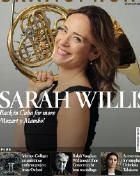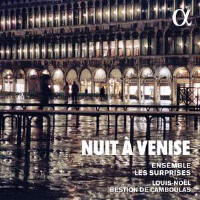Texte paru dans: / Appeared in: |
|
|
Outil de traduction |
|
|
Louis-Noël Bestion de Camboulas explains that ‘A Night in Venice’ aims ‘to reimagine a large-scale evening of festivities on the Piazza San Marco and in the Basilica, but also in the gardens and salons of the city’s palaces … a night of festive celebration … [that mingles] the sacred and profane, the intimate and the grandiose, dance and contemplation’. The concept should not be taken seriously: our 70-minute stroll around La Serenissima starts in about 1607 and finishes approximately 100 years later (a long evening by any standard), and it encompasses brief samples of at least eight different church services happening in a topsy-turvy ecclesiastical world in which two different Vespers (each with music from the 1640s) can both occur before two different Masses. In reality, this is a fun excuse for an entertaining mixture of Venetian church music interspersed with seven brief instrumental pieces mostly by composers who were employed in Cremona, Brescia and Mantua. There are also two sacred contrafacta of dissimilar Monteverdi madrigals (Ambrosius Profe’s version of ‘Parlo, miser, o taccio?’ and Aquilino Coppini’s parody of ‘Ferir quel petto, Silvio?’). Ensemble Les Surprises kick off with a playful interpretation of Monteverdi’s second Dixit Dominus from Selva morale e spirituale (1641); the expressive flexibility of eight singers is matched stride for stride by the ensemble of two violins, one cornett, viola da gamba, dulcian, theorbo and harpsichord, directed from the organ by Bestion de Camboulas. Grandi’s three-voice O quam tu pulchra es (Il primo libro de motetti, 1610) is sung by male voices with seductive tenderness. Rigatti’s Magnificat from Messa e Salmi ariosi (1643) has a lightness of touch yet also moments of splendour, such as a gutsy cornett fanfare, thrusting dulcian and declamatory tenor in the arioso ‘Fecit potentiam’. Quicksilver recorders in the rushed start of Monteverdi’s Laudate Dominum omnes gentes (Selva morale) are unconvincing, although descending chains of chromaticism at the words ‘nos misericordia eius’ are handled wonderfully, and the small choir embraces rising dissonances and harmonic inflections fulsomely in Lotti’s eight-voice Crucifixus. The lament ‘Oro supplex’ from Legrenzi’s Prosa pro mortuis (a setting of the Dies irae, c1688) is performed dulcetly by countertenor Paulin Bündgen in dialogue with violin and recorders. There is a tender fusion of madrigalian clarity and sacred piety in Legrenzi’s Salve regina (Compiete con le lettanie & antifone, 1662). Alpha’s woefully inadequate booklet fails to identity the origins of almost all of the featured music and does not credit soloists properly. |
|




